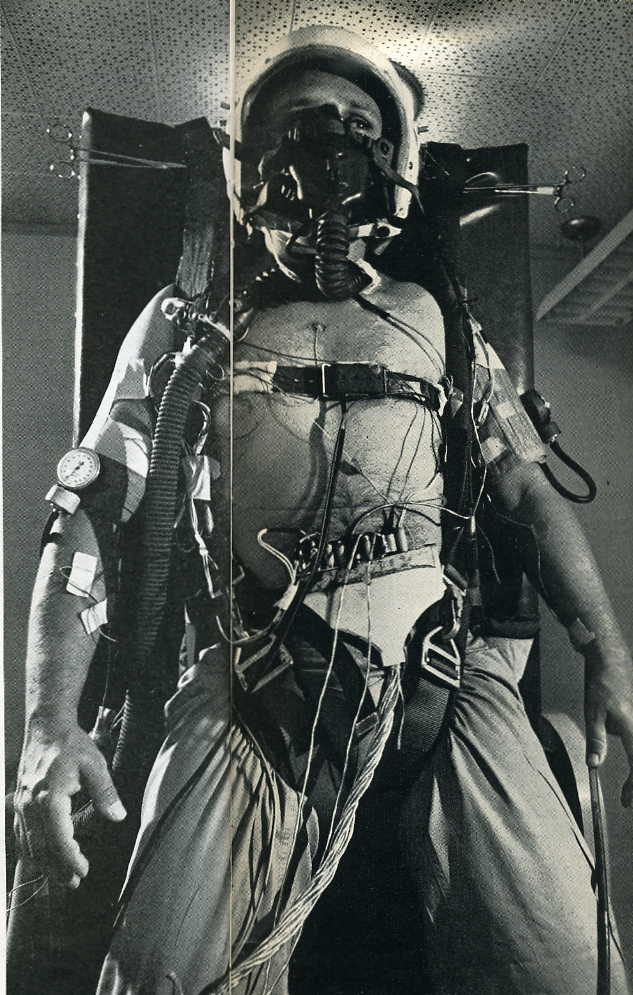
NASA MAKING CYBORG MAN
Cybernetics is the study of the relationship between
computing machines and the human nervous system...
There are scientists who now believe that
the human body could be run cybernetically,
i.e., it could be automated....
The Cyborg, though cybernetically controlled, would be a human being--
if, after radical tampering, he could still be called that.
...continued from ASTRO RADIATION NOT
THE LAST BARRIER IS MAN HIMSELF
A bizarre new science, bioastronautics, prepares us for experiences without precedent
LIFE Magazine, Oct 2, 1964
by Albert Rosenfeld, pages 122-124
...Spacecraft designing could be greatly simplified if man were more durable. Dr. Freedman thinks our goal should be what he calls Optiman--"a man whose outward appearance is quite normal, but who has been adapted to the oxygen requirements of a Himalayan Sherpa, the heat resistance of a walker-on-coals, who needs less food than a hermit, who has the strength of a Sonny Liston, and runs the mile in 3 minutes flat while solving problems in tensor analysis in his head."
Many scientists go along with the Optiman goal and some are actually doing experiments toward achieving it. Others want to study the possible uses of hypnosis and extrasensory perception in space flight. But going far beyond Optiman or any similar proposal is the concept of the Cyborg (for cybernetic organism).
Cybernetics is the study of the relationship between computing machines and the human nervous system. It deals with the art of handling vast quantities of information, running the data through complex computing systems which then feed back new and useful data. To run an automated oil refinery, for example, data are constantly being absorbed and fed back in order to carry out all the intricate industrial processes involved. There are scientists who now believe that the human body could be run cybernetically--i.e., it could be automated--in a similar fashion, though the job would be much harder. The Cyborg, though cybernetically controlled, would be a human being--if, after radical tampering, he could still be called that.
As originally conceived by Dr. Nathan Kline and Manfred Clynes at the Rockland State Hospital in Orangeburg, N.Y., a Cyborg would still look like a man, but an unearthly one indeed. He would be encased in a skintight suit, needing no pressurization because his lungs would be partially collapsed and the blood in them cooled down while respiration--and most other bodily processes--would be carried on for him cybernetically by artificial organs and senses, some of them attached to the outside of his body, some of them implanted surgically. His mouth and nose, too, would be sealed over by the suit, because he would not need them to breathe with. Cyborgs would communicate with one another by having the electrical impulses from their vocal cords transmitted by radio. The artificial organs--actually a tiny, complex computer system constantly receiving and feeding back information to regulate the body to its changing environment--would keep a Cyborg's metabolism steady despite radical fluctuations in external temperatures and pressures. The Cyborg could travel in an unsealed cabin through the vacuum of space, walk around on the moon or on Mars protected from heat, cold or radiation by a variety of chemicals and concentrated foods being pumped directly to the stomach or bloodstream. Wastes would be chemically processed to make new food. The tiny bits of totally worthless waste matter would be deposited automatically in a small canister carried on the back.
The Cyborg has a good many detractors--even among the boldest thinkers in bioastronautics, including men like North American's Dr. Freedman and Dr. Strughold of the Air Force. They believe the Cyborg concept would ultimately prove to be unworkable. More than that, they find the whole idea of the Cyborg repugnant. Nevertheless, many scientists think the basic approach has value, and NASA, not wanting to leave a path unpursued, has issued a preliminary study and development contract for Cyborg systems to the Hamilton Standard Division of United Aircraft.
Dr. Michael Del Duca of NASA feels that the Cyborg is only one way to exploit cybernetic possibilities. He believes, for example, that man could use photosynthesis just as plants do, converting sunlight directly into energy; that cybernetic regulation could be accomplished by sophisticated chemicals which would be permeable to the skin, moving wherever they were needed inside or outside the body. Thus man would find space no longer hostile and he could move unencumbered anywhere in the accessible universe.
But whatever the future may bring in the form of Optiman, the Cyborg man or Photosynthetic man, the space engineers of today are stuck with 1964 man, the fragile hothouse flower nurtured in the shelter of earth's atmosphere. It has been said of manned spacecraft that "the only component that spoils the design is the human." Just the same, between now and the end of this decade the engineers and doctors are expected to figure out how to wrap this design-spoiling human in a protective cocoon and get him across 240,000 miles of black and baleful space to the moon and back.
Implants turn humans into cyborgs (RFID chips already commonly used in livestock & merchandise tracking). VancouverSun, Jan 7, 2006
3.Surveillance & 20.Thought Police & 41.Big Brother Tells How & 42.Big Brother Tells Why
Jackie Jura
~ an independent researcher monitoring local, national and international events ~
email: orwelltoday@gmail.com
HOME PAGE
website: www.orwelltoday.com